There has been much discussion and hype happening for some time now about how industries are undergoing a “digital transformation.” This phrase can take on multiple definitions, strategies, and technologies depending on the specific industry involved. For manufacturers in the discrete industries (automotive, A&D, machines & equipment, medical devices, etc.) a digital transformation can translate to technology and solutions that enable a completely connected digital enterprise encompassing an end-to-end virtual lifecycle of product design, manufacturing processes, shop floor production systems, operational support and maintenance, and service in the field.
Terms like Industrial Internet of Things (IIoT) and Industrie 4.0 come to mind, and represent strategies and architectures that define a physical/cyber system of systems that connects the end-to-end lifecycle together. This technology and solution set is typically offered by leading PLM suppliers, and is often referred to as “closed-loop PLM.” This instance of the digital enterprise is referred to as the “digital thread” that ties all aspects of the product lifecycle together and enables all product stakeholders – product design, manufacturing and production systems, as well as product services – to be able to work from a common repository of digital information.
An important aspect and enabler of the digital thread is the concept of the “digital twin”, where the physical and virtual worlds of the product, including its engineering design and operational functions, are connected and merged to enable everything from design improvements, continuous process improvements, conditional states of the machine/system, to operations and maintenance. Manufacturing OEMs, and capital equipment suppliers are taking a hard look at existing business models around maintenance and support of their equipment. Using predictive and prescriptive analytics and the concept of continuous condition monitoring, they are considering new business models based on services and support – where the OEM maintains ownership of the equipment and sells a service to the customer.
This same concept of the digital thread can, and is, being applied to the design /construct / operate /maintain lifecycle of Building Information Modeling (BIM). One of the basic tenets of BIM is to provide an environment for the access and exchange of engineering design, procurement and materials management, and construction information across the Capex lifecycle. This continuum of design/construct information is now being extended to the Opex side of the lifecycle for asset management and operations and maintenance. The concept of asset information lifecycle management (ALIM) comes into play here. BIM is primarily a set of solutions for the Capex lifecycle today, but engineering – and even construction – information is needed by the owner-operator, whether the facility is a process plant or an office building complex.
BIM is an evolving concept that will modernise the construction industry. In its earliest iterations, the acronym “BIM” was appropriately used to describe CAD tools used in building design. For over two decades this definition held true. However, within the past five years, the term BIM has been increasingly used to describe a set of technologies, and today, a set of standards much more pervasive in building lifecycles.
So, what is this new BIM? The Associated General Contractors of America describe BIM as an object-oriented building development tool that utilises 4D and 5D modeling concepts, information technology, and software interoperability to design, construct, and operate a building project, as well as communicate its details. In BIM terms, 5D is the linking of a 3D model with schedule and cost information, adding the 4th and 5th dimensions, respectively.
This evolution is driven by the need for a comprehensive design, construction, and hand-off process that allows for multidisciplinary input and management at each stage. Such a process is imperative for preventing the miscommunications, cost overruns, and schedule slippages that plague large capital construction projects. Organisations like Hexagon PPM have recognised that any such process must rely on a building model as the single source of truth, with all project information tied back to it. The concept of the digital thread fits very nicely with the notion of BIM information across a Capex/Opex lifecycle. Similarly, the concept of the digital twin that merges the physical world of assets with the virtual world of engineering design, works to sustain asset management.
I believe that this re-imagining of BIM could influence the architecture, engineering, and construction (AEC) industry in the same way that PLM has influenced the automotive industry. But what is the bigger picture? Will BIM change how capital projects are managed across industries? Will reduced risk and faster turnaround time prompt more frequent spending on capital projects or public infrastructure? How might BIM influence the development of smart buildings? We explored some of these questions and others in the panel session for Digital Transformation in Operations at HxGN LIVE 2018.
![]() Dick Slansky
Dick Slansky
Senior Analyst Research Director
PLM & Engineering Design Tools
ARC Advisory Group

















